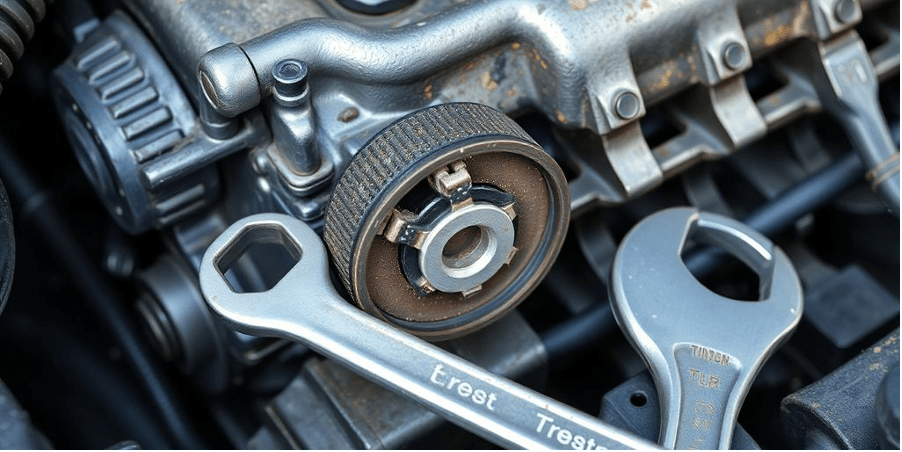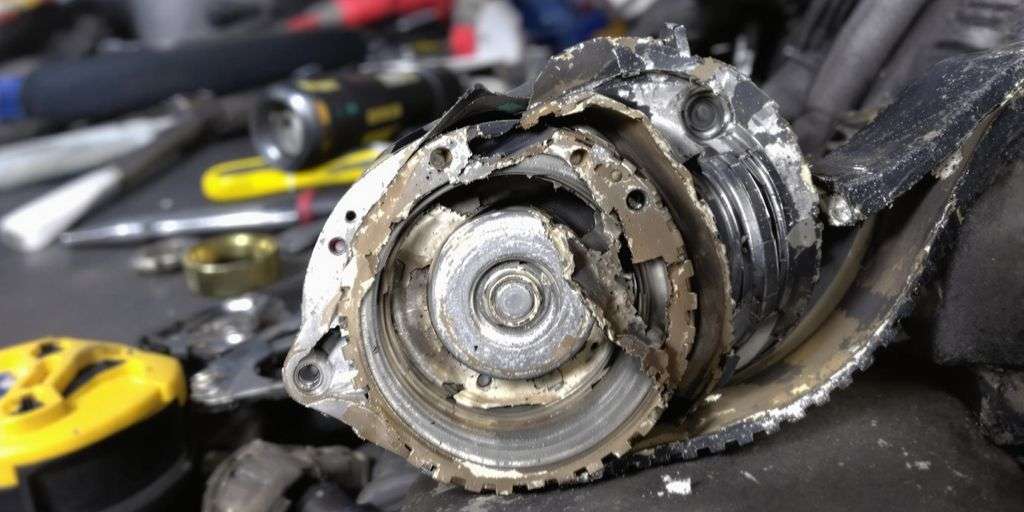Key Takeaways
- Understand what a timing belt tensioner is and how it affects your car.
- Evaluate the car's overall condition and market value before making decisions.
- Weigh the pros and cons of repairing the timing belt tensioner versus selling the car as-is.
- Highlight the car's strengths and be upfront about the timing belt issue when selling.
- Explore various selling options, including dealerships, private sales, and online platforms.
Understanding the Timing Belt Tensioner Issue
What is a Timing Belt Tensioner?
A timing belt tensioner is a small but crucial part of your car's engine. It keeps the timing belt tight, ensuring the belt runs smoothly and maintains the proper timing between the crankshaft and camshaft. Without this tensioner, the belt could slip or even break, leading to serious engine trouble. Think of it as the unsung hero that keeps everything in sync under the hood.
Common Symptoms of a Broken Timing Belt Tensioner
When the timing belt tensioner is on the fritz, your car might give you some warning signs. Here’s what to look for:
- Odd Noises: A squealing or grinding sound coming from the engine could be a hint that the tensioner is failing.
- Vibrations: If you feel unusual vibrations, especially when idling, it might be the tensioner.
- Engine Misfires: The engine might misfire if the belt isn’t properly tensioned.
Potential Damage from a Broken Timing Belt Tensioner
Ignoring a faulty timing belt tensioner can lead to some nasty problems. If the tensioner fails completely, the timing belt can slip off or break. This can cause:
- Bent Valves: When the belt slips, the engine’s pistons and valves might collide, bending the valves.
- Piston Damage: The pistons can also suffer damage if they hit the valves.
- Engine Breakdown: In the worst-case scenario, the engine could stop working altogether.
Bold statement: It's crucial to address any issues with the timing belt tensioner promptly to avoid costly repairs.
For more info on timing belts and their role in engine performance, you can explore various resources that explain how they synchronize engine components and what happens when they fail.
Evaluating the Car's Current Market Value
Assessing the Car's Condition Beyond the Timing Belt Issue
When you have a car with a broken timing belt tensioner, it's easy to focus solely on that issue. But don't forget to look at the rest of the vehicle. Check the overall condition—are the tires in good shape? How's the interior? Is the paint job holding up? Sometimes, a car has a lot going for it even if one part is failing. It's like having a house with a leaky roof but a fantastic kitchen and living room.
Researching Comparable Car Sales
To get a sense of what your car might fetch, look at similar cars being sold. Check out listings for cars with the same make, model, and year, especially those with similar mileage. You might notice that cars with minor issues still sell for a decent amount. Keep an eye out for patterns and price ranges, which can give you a ballpark figure.
Consulting with Automotive Experts
Sometimes, you just need a pro's opinion. Talk to mechanics or car appraisers about your car's situation. They can offer insights into how much the timing belt issue might affect your car's value. Plus, they might have tips on how to present your car to buyers.
“Even with a broken timing chain, there's often a way to make the sale work in your favor. Whether it's through strategic repairs or highlighting the car's strengths, expert advice can be invaluable.”
Repair or Sell As-Is: Making the Decision

Cost Analysis of Repairing the Timing Belt Tensioner
Deciding whether to fix the timing belt tensioner can be tough. Repairing it might cost a hefty sum, but it could also increase the car's resale value. Typically, fixing a broken timing belt tensioner can set you back anywhere from $500 to $2000, depending on the car model and labor costs. If your car is otherwise in good condition, repairing might make it more appealing to buyers.
Pros and Cons of Selling the Car As-Is
Selling the car in its current state might seem like a quick solution. Here are some things to consider:
- Pros:
-
- Quick sale without the hassle of repairs.
- No upfront repair costs.
- Attracts buyers looking for a bargain or project car.
- Cons:
-
- Lower selling price.
- Fewer interested buyers.
- Potential buyers might replace the timing belt and related parts themselves, which can be a selling point if disclosed.
Factors Influencing the Decision to Repair
Several factors can sway your decision to repair or sell:
- Financial Situation: Can you afford the repair costs upfront?
- Car's Overall Condition: Is the car in good shape aside from the timing belt issue?
- Market Demand: Are there buyers looking for your car model, even with some issues?
Making the decision to repair or sell as-is requires weighing the current market conditions, your financial situation, and the car's overall appeal. Consider all angles before making a move.
Strategies for Selling a Car with Mechanical Issues
Highlighting the Car's Positive Features
When selling a car with mechanical problems, it's crucial to emphasize its positive aspects. Highlight features like low mileage, a clean interior, or recent upgrades. Make a list of all the good points about the car and be ready to share these with potential buyers. This way, you can shift the focus from the mechanical issues to the car's strengths.
Being Transparent About the Timing Belt Issue
Honesty is the best policy when selling a car with known problems. Be upfront about the timing belt tensioner issue. Explain what the problem is and how it affects the car. Transparency can build trust with buyers, making them more likely to consider your vehicle despite its issues.
Negotiating with Potential Buyers
Negotiation is key when selling a car with mechanical issues. Be prepared for buyers to want a lower price due to the necessary repairs. However, you can use the car's positive features as a bargaining chip. Start with a fair asking price and be open to reasonable offers. Having done your homework on similar car sales can give you an edge in these discussions.
Selling a car with mechanical problems might seem tricky, but with the right approach, you can still make a fair deal. Focus on the car's strengths, be honest about its issues, and be ready to negotiate. This way, you'll find the right buyer who appreciates what your car has to offer, even with its quirks.
Exploring Alternative Selling Options
Selling to a Dealership vs. Private Sale
When you're looking to sell a car with a mechanical issue like a broken timing belt tensioner, you have a couple of options: selling to a dealership or going the private sale route. Dealerships might offer less money, but they take the hassle out of the process. They handle all the paperwork, and you won't have to worry about finding a buyer. On the other hand, a private sale could get you more cash, but it requires more effort. You'll need to advertise, meet with potential buyers, and negotiate the price.
Considering Online Car Selling Platforms
Online platforms have really changed the game when it comes to selling cars. Websites and apps let you reach a wider audience, making it easier to find someone interested in your car, even with its issues. Some platforms even specialize in buying cars “as-is,” so you don't have to worry about repairs. Just be honest about the car's condition in your listing.
Exploring Trade-In Opportunities
If you're planning to buy another car, trading in your current vehicle can be a good option. Dealerships often accept trade-ins, and while they might not give you top dollar for a car with mechanical problems, it can reduce the amount you need to finance for your next car. Plus, it's convenient since you can handle buying and selling in one go.
When deciding how to sell your car, think about your priorities: convenience, time, and how much money you want to get from the sale. Each option has its pros and cons, so weigh them carefully before making a decision.
For those considering cars with different timing belt systems, wet timing belts offer advantages like reduced wear and noise, which might influence your next purchase decision.
Preparing the Car for Sale

Cleaning and Detailing the Car
First impressions matter a lot when selling a car. A clean car can significantly boost a buyer's interest. Start by thoroughly washing and waxing the exterior to make it shine. Don't forget the windows; they should be spotless. Inside, vacuum the seats and carpets, wipe down all surfaces, and consider using an air freshener for a pleasant scent. If you want to go the extra mile, professional detailing can make your car look almost new.
Gathering Necessary Documentation
Having all the paperwork ready can make the selling process smoother. Gather the car's title, registration, and any maintenance records. These documents show that you've taken good care of the car and can help build trust with potential buyers. If the car has had any major repairs, like fixing a timing belt issue, it's good to have those receipts handy too.
Setting a Competitive Asking Price
Pricing your car right is crucial. Start by researching similar cars in your area to see what they're selling for. Consider the car’s condition, mileage, and any recent repairs when setting your price. A well-priced car will attract more buyers, and you can always negotiate if needed. Remember, the goal is to find a price that reflects the car's value while being attractive to buyers.
Legal and Ethical Considerations
Disclosing Mechanical Issues to Buyers
When selling a car, it's crucial to be upfront about any known mechanical issues, including a broken timing belt tensioner. Transparency builds trust with potential buyers and can prevent future disputes. Consider providing a detailed history of the car's maintenance and any recent repairs, which can help buyers understand the vehicle's condition.
Understanding Lemon Laws and Consumer Rights
Lemon laws vary by state, but they generally protect consumers from defective vehicles. As a seller, it's important to understand these laws to avoid legal trouble. If you're selling a car “as-is,” make sure to clearly state this in the sales agreement. This can help protect you from liability if the buyer experiences issues after the purchase.
Ensuring a Fair and Honest Transaction
To ensure a fair transaction, both parties should agree on the car's condition and price. Here are some steps to follow:
- Provide a Vehicle History Report: This report can give buyers confidence in the car's past.
- Encourage an Independent Inspection: Allowing the buyer to have the car inspected by a mechanic of their choice can further establish trust.
- Document Everything: Keep records of all communications and agreements to avoid misunderstandings.
Selling a car with mechanical issues doesn't have to be a headache if you approach it with honesty and clarity. Being upfront about the car's condition can lead to a smoother transaction for both parties.
Wrapping It Up: Selling Your Car with a Broken Timing Belt Tensioner
So, there you have it. Selling a car with a busted timing belt tensioner isn't the end of the world, but it does take a bit of strategy. Weigh your options carefully. If the repair costs are sky-high, maybe selling as-is to someone who loves a project is the way to go. On the flip side, if you can swing the repair, it might boost your car's value enough to make it worthwhile. Either way, be upfront with potential buyers about the car's condition. Honesty can go a long way in making a sale smoother and keeping your conscience clear. Good luck, and may your next car be trouble-free!
Frequently Asked Questions
What does a timing belt tensioner do?
A timing belt tensioner keeps the timing belt tight and in place, ensuring the engine's parts move in sync.
How can I tell if my timing belt tensioner is broken?
Signs of a broken tensioner include strange noises from the engine, the engine misfiring, or the car not starting.
Can I drive with a broken timing belt tensioner?
It's not safe to drive with a broken tensioner because it can lead to severe engine damage.
How much does it cost to fix a timing belt tensioner?
Repairing a timing belt tensioner can cost between $500 and $1000, depending on the car model and labor costs.
Should I repair my car before selling it?
Consider the repair cost versus the car's value. If repairs increase the value more than the cost, it might be worth fixing.
What if I decide to sell my car as-is?
Be honest about the car's condition with buyers. Some might be interested in fixing it themselves if the price is right.



